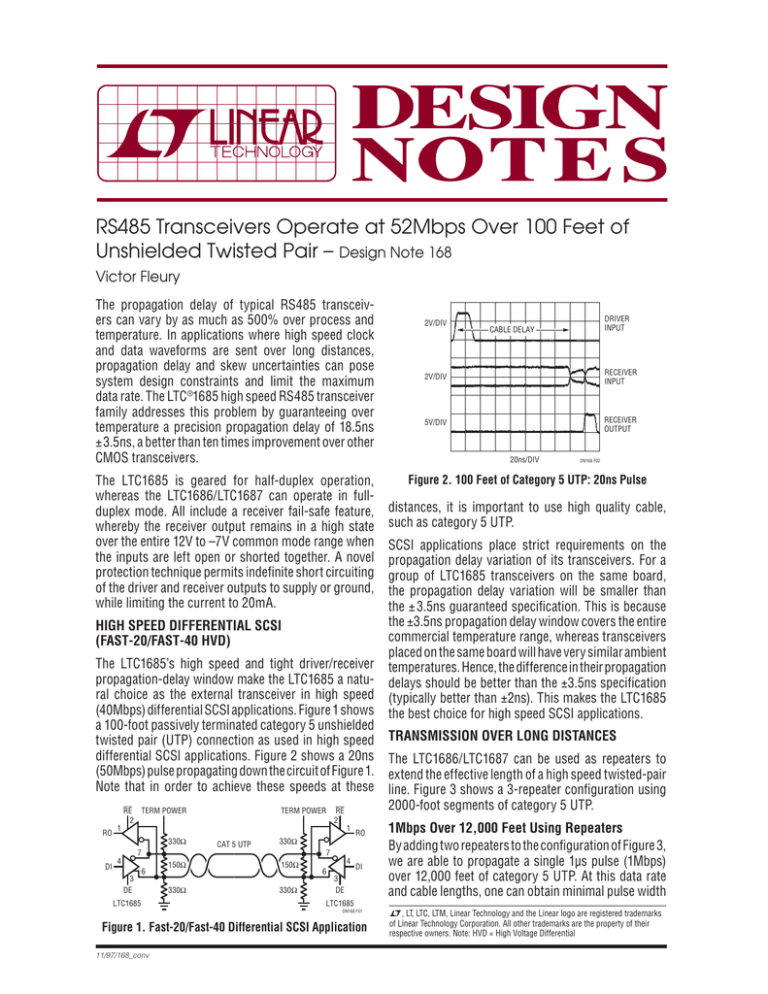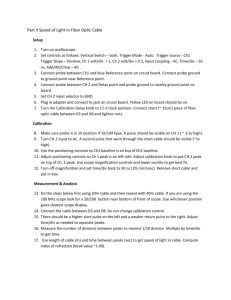DN168 - RS485 Transceivers Operate at 52Mbps Over 100 Feet of
advertisement

RS485 Transceivers Operate at 52Mbps Over 100 Feet of Unshielded Twisted Pair – Design Note 168 Victor Fleury The propagation delay of typical RS485 transceivers can vary by as much as 500% over process and temperature. In applications where high speed clock and data waveforms are sent over long distances, propagation delay and skew uncertainties can pose system design constraints and limit the maximum data rate. The LTC ®1685 high speed RS485 transceiver family addresses this problem by guaranteeing over temperature a precision propagation delay of 18.5ns ±3.5ns, a better than ten times improvement over other CMOS transceivers. The LTC1685 is geared for half-duplex operation, whereas the LTC1686/LTC1687 can operate in fullduplex mode. All include a receiver fail-safe feature, whereby the receiver output remains in a high state over the entire 12V to –7V common mode range when the inputs are left open or shorted together. A novel protection technique permits indefinite short circuiting of the driver and receiver outputs to supply or ground, while limiting the current to 20mA. HIGH SPEED DIFFERENTIAL SCSI (FAST-20/FAST-40 HVD) The LTC1685’s high speed and tight driver/receiver propagation-delay window make the LTC1685 a natural choice as the external transceiver in high speed (40Mbps) differential SCSI applications. Figure 1 shows a 100-foot passively terminated category 5 unshielded twisted pair (UTP) connection as used in high speed differential SCSI applications. Figure 2 shows a 20ns (50Mbps) pulse propagating down the circuit of Figure 1. Note that in order to achieve these speeds at these RE TERM POWER 2 RO TERM POWER 1 330Ω CAT 5 UTP 4 3 DE 6 LTC1685 RO 330Ω 7 DI RE 2 1 7 150Ω 330Ω 150Ω 330Ω 4 6 DI 3 DE DRIVER INPUT CABLE DELAY 2V/DIV RECEIVER INPUT 5V/DIV RECEIVER OUTPUT 20ns/DIV DN168 F02 Figure 2. 100 Feet of Category 5 UTP: 20ns Pulse distances, it is important to use high quality cable, such as category 5 UTP. SCSI applications place strict requirements on the propagation delay variation of its transceivers. For a group of LTC1685 transceivers on the same board, the propagation delay variation will be smaller than the ± 3.5ns guaranteed specification. This is because the ±3.5ns propagation delay window covers the entire commercial temperature range, whereas transceivers placed on the same board will have very similar ambient temperatures. Hence, the difference in their propagation delays should be better than the ±3.5ns specification (typically better than ±2ns). This makes the LTC1685 the best choice for high speed SCSI applications. TRANSMISSION OVER LONG DISTANCES The LTC1686/LTC1687 can be used as repeaters to extend the effective length of a high speed twisted-pair line. Figure 3 shows a 3-repeater configuration using 2000-foot segments of category 5 UTP. 1Mbps Over 12,000 Feet Using Repeaters By adding two repeaters to the configuration of Figure 3, we are able to propagate a single 1μs pulse (1Mbps) over 12,000 feet of category 5 UTP. At this data rate and cable lengths, one can obtain minimal pulse width LTC1685 DN168 F01 Figure 1. Fast-20/Fast-40 Differential SCSI Application 11/97/168_conv 2V/DIV L, LT, LTC, LTM, Linear Technology and the Linear logo are registered trademarks of Linear Technology Corporation. All other trademarks are the property of their respective owners. Note: HVD = High Voltage Differential LTC1687 LTC1687 2000 FEET D1 2000 FEET LTC1687 R2 D LTC1687 R3 2000 FEET R4 D 2000 FEET D R5 REPEATER REPEATER REPEATER LTC1687 R DN168 F03 Figure 3. 1.6Mbps, 8000 Feet (1.5 Miles) Using Three Repeaters DRIVER 1 INPUT 2V/DIV 2V/DIV DELAY OF 12,000 FEET OF CABLE DRIVER INPUT RECEIVER 2 INPUT RECEIVER 3 INPUT RECEIVER 4 INPUT 1V/DIV 1V/DIV 1V/DIV RECEIVER 5 OUTPUT (8000 FEET) 5V/DIV 2μs/DIV 5μs/DIV DN168 F04 Figure 4. Differential Signals at the Far End of the First Three 2000-Foot Cable Segments degradation as the signal traverses through the repeater network. Figure 4 shows some receiver input and output signals at the far end of the first three 2000-foot cable segments of the network. The DC resistance of 2000 feet of category 5 UTP divides the signal nearly in half. AC losses tend to filter the 1μs pulse. The total attenuation is shown by the middle three traces of Figure 4. Note, however, that the output pulse (bottom trace) is nearly the same width as the input pulse (top trace), meaning that the LTC1687 repeaters are able to regenerate the signal with little loss in pulse width. Figure 5 shows the waveforms at the near and far end of the entire 12,000-foot network. The imperceptible loss in pulse width implies that we can cascade even more repeater networks and potentially achieve 1Mbps operation at total distances of well over 12,000 feet ! 1.6Mbps Over 8000 Feet Using Repeaters For the same cable distance, high data rates will limit the maximum number of repeaters. Figure 6 shows the propagation of a single 600ns pulse through the 3-repeater network of Figure 3. The bottom two traces show a 1.6Mbps square wave at the input and output of the network, respectively. Notice that the duty cycle does not noticeably degrade, however, there is a degradation of the pulse width as shown in the second trace. Thus, in Data Sheet Download www.linear.com Linear Technology Corporation RECEIVER OUTPUT (12,000 FEET) 2V/DIV DN168 F05 Figure 5. 1μs Pulse Over 12,000 Feet Category 5 UTP 2V/DIV DRIVER 1 INPUT DELAY OF 8000 FEET OF CABLE 5V/DIV RECEIVER 5 OUTPUT 2V/DIV DRIVER 1 INPUT 5V/DIV RECEIVER 5 OUTPUT 2μs/DIV DN168 F06 Figure 6. 1.6Mbps Pulse and Square Wave Signals Over 8000 Feet Category 5 UTP Using Three Repeaters order to achieve reliable performance at long distances, a compromise must be reached between cable distance and quality, data rate and number of repeaters. CONCLUSION The LTC1685 family of high speed RS485 transceivers allows for up to 52Mbps transmission over reasonable distances (100 feet), as well as moderate speed over long distances (1.6Mbps, 2000 feet). Using repeaters can substantially increase the effective length. At 1.6Mbps, three repeaters can carry data a total of 8000 feet and five repeaters can carry 1Mbps data over 12,000 feet of category 5 UTP. For applications help, call (408) 432-1900 dn168f_conv LT/TP 1197 370K • PRINTED IN THE USA 1630 McCarthy Blvd., Milpitas, CA 95035-7417 (408) 432-1900 ● FAX: (408) 434-0507 ● www.linear.com © LINEAR TECHNOLOGY CORPORATION 1997




